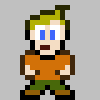I''m exagerrating to an extent, but I''m also including checking device capabilities, setting up a clipper, changing the display mode to what the user requests, catching errors, resetting everything when the window loses focus, and other things that would be required in a game, all of which is implemented in a modular way...so it is a lot of code for me.
When I was doing direct draw, there was no load from file function included (that I could find). There was no copy from here to there included (that I could find). All of that was manual, without downloading third party functions, which I just don''t like to do.

So that affects part of what I consider as more code. I should have said direct draw in general, not just the initialization.
I''m just thinking back when I used direct draw before and realizing that it is indeed easier to use D3D now. That''s my only point, whether it takes a thousand lines of code or not doesn''t matter much. It is easier to me, and I think Vic will find it easier in the long run. It will help him get into D3D, which he''ll probably start to work with afterwards anyway.
Good luck,
Chris
*Life is like the rock in a sling-shot. Pick a good target, take good aim, and get there as soon as possible!*



